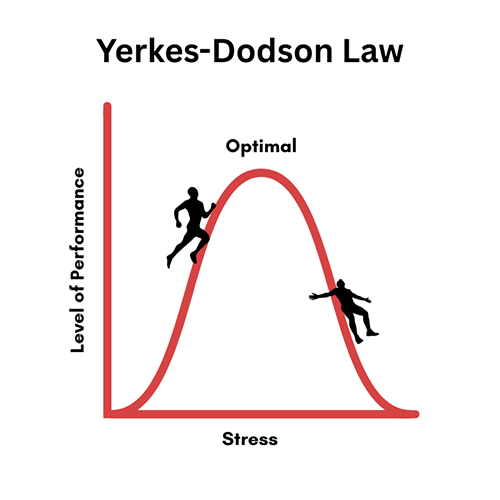Blog Short #258: Is Stress Stealing Your Focus? Here’s How to Get It Back!

Photo by Jacob Wackerhausen
Too much stress destroys your ability to focus. It’s like a grenade shattering your attention as you scramble to keep yourself steady.
Today, we’re reviewing the positive and negative effects of stress on your ability to focus and the most effective method for sharpening and controlling your attention.
We’ll start with a brief description of the types of attention.
The Three Types of Attention
In her book Peak Mind, Dr. Amishi Jha defines three categories of attention. It’s worth knowing these because they’ll help you rein in your attention based on the type you need.
1. Selective Attention (Flashlight)
Selective attention is the type you usually think of when talking about focusing. It narrows in on something and spotlights it. Meanwhile, distractions are muted so you can concentrate without interruptions. It functions like a flashlight with a steady, narrow beam.
You can use selective attention to focus on something in your outside environment, or turn it inward to focus on your internal environment, including thoughts, feelings, your body, and memories.
2. Alerting System (Floodlight)
Now imagine your flashlight shining with a wide beam, like a floodlight. You use this type of attention when you enter a room and scan it to get a panoramic view of what’s there and what’s going on.
Alerting attention focuses on the present moment. It’s broad, diffuse, and receptive. You use it in social settings, when walking into a meeting, or when brainstorming. You’re ready to pivot based on what’s happening right now.
Again, like selective attention, alerting attention can be applied to both your external and internal environments.
3. Executive Functioning (Juggler)
Dr. Jha likens executive attention to being a juggler. A juggler has many balls in the air and can switch attention back and forth quickly and with precision to keep them going without dropping any of them.
Executive attention derives its name from its reliance on executive functions.
An executive creates and manages a system to help you reach your goals. He oversees, monitors, and coordinates all aspects of the system to maximize results.
We’ll come back to a strategy that helps you sharpen all three types of attention, but first, let’s look at the effects stress has on them.
The Effects of Stress
Let’s start with several facts you need to know up front.
First, your ability to attend doesn’t fully mature until the age of 25, as does your brain.
That means you might mistake having ADHD during your teens when, in reality, it’s a matter of your attentional system not yet being fully developed. Not always, of course.
Now for some sobering news:
Your brain and attentional system start declining by age 35, and sometimes earlier.
Ugh! That means you need to learn how best to preserve both to slow down the decline.
Now for stress.
The upside is that you actually need a certain amount of stress to attend. In other words, you need a burst of energy and some urgency to kick your mind into gear enough to get going. Dopamine is part of this process.
On the other hand, once you reach a certain level of attention and keep applying stress, you get diminishing returns. Your attention starts to fade, making it harder to maintain.
This shift of attention due to increased stress is called the Yerkes-Dodson Law. See the diagram below for an illustration of how this works.

You’ve likely experienced this. You get motivated, start working on something, and attend more easily as you get into the flow. But at a certain point, you’ve reached the peak of your energy, and your attention begins to decline.
Often, we push ourselves beyond this point and keep going, but the benefits decrease. If you continue, you get fewer and fewer returns.
Stress peaks when you become overwhelmed and have to put in more and more effort to keep up with your tasks.
It also rises when you’re struggling with internal issues that cause worry, anxiety, or mood disturbances.
In short, two primary obstacles to maintaining attention are:
- Time-related stressors
- Emotions
Here are some strategies to help with both.
#1: Single-Mindedness
Think of attention as a strong Wi-Fi signal. When it’s working well, you get a clear picture on your computer, your TV streaming works, and there’s no fluctuation. But when it’s spotty, it goes on and off rapidly. You could be Zooming with someone, and their image freezes for a moment, or what they’re saying is out of sync with their mouth movements.
This process occurs when you’re multitasking or when you’re constantly interrupted while working.
The more focused and single-minded you are when doing just one thing, the less stressful it becomes. Not to mention, you perform better.
Everyone knows this, but we easily forget it. Practicing this daily helps retrain your mind to focus.
If you spend a lot of time online, you’ve probably weakened your ability to focus on one thing at a time, especially if you’re doing several things simultaneously. You might be watching TV, scrolling through Facebook, and having a conversation all at once.
This type of activity will eventually leave you unable to attend to any single-minded pursuit for any length of time.
Do one thing at a time.
#2: Create Emotional Space
Emotions can help you attend. If you have a strong interest in something, you do it easily. But emotions can also be a major detractor.
You’re trying to finish a report at work, but your mind keeps reverting to worry about one of your kids. You’re having catastrophic fantasies about what could go wrong. Finally, you give up and take a break because you can’t concentrate.
Our minds can’t tell the difference between doing something and imagining it. The stress is the same in either case.
So if you’re worrying and imagining worst-case scenarios, your stress response will drain your attention, as if something were actually happening around you.
In other words, emotions expend a lot of energy and effectively distract you from attending to what you want to focus on.
The antidote to all of this is to create emotional space so you can control how you respond to both internal and external stimuli. You can best achieve this through mindfulness meditation.
If you haven’t tried meditation and aren’t particularly enthused about it, don’t say no yet.
Dr. Jha cites extensive research showing that 12 minutes of mindfulness meditation per day, four days a week, engages all three types of attention and maintains it even under stress.
The method used during the research was to simply watch your breath, sitting quietly for 12 minutes. I’ve attached the specific directions so that you can try it.
I’ve meditated daily for many years. I remember when I started, I felt the effects immediately, which was helpful because it motivated me to keep going. But even more motivating are the cumulative effects you continue to experience the longer you practice.
You reach a point where you feel a sense of space in your mind, regardless of what’s happening around you. Because of that, you can respond to anything more intentionally.
That doesn’t mean you don’t get stressed out, but it happens less often, less intensely, and to a lesser degree.
For the very little time it takes, the positive effects are remarkable.
There are additional benefits beyond attention, including mood stabilization, creativity, patience, calmness, tolerance, and resilience.
#3: Remove Stressors
The last strategy is to work on removing stressors instead of stress.
Stress is your response to a stressor, not the other way around.
To reduce stress, you need to cut out the things that cause it – bad relationships, the wrong jobs, self-destructive behaviors, too little sleep, poor eating habits, and so on.
Take an inventory. What’s stressing you out most? List them and prioritize them. Then decide which of them you can remove and make a plan to do that.
Even if it takes time to remove a stressor, simply identifying it and making a plan will help.
Last Note
We’re approaching the holidays at lightning speed, but hopefully you’ll have some time after them to think about and try some of these ideas.
Don’t forget to check out the attached meditation instructions. I’ve also listed a few previous articles that might help.
That’s all for today!
Have a great two weeks!
All my best,
Barbara
Suggested Reading:
Mindfulness Meditation Instructions.pdf
How to Effectively Deal With Stressors
Stress-Release Strategies That Help You Avoid Burnout









